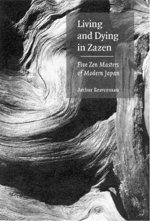Living and Dying in Zazen:
Five Zen Masters of Modern Japan
Arthur Braverman
New York & Tokyo: Weatherhill, 2003
176 pp.; $16.95 (paper)
In the late sixties, young, wide-eyed Westerners inspired by the writings of D. T. Suzuki and Alan Watts began arriving in Japan to study Zen. The conservative Buddhist establishment was largely unprepared to welcome these outsiders, most of whom did not speak the language and were untutored in the nuances of Japanese society. But a few temples with broad-minded roshis bravely opened their doors.
Two of those temples were situated near one another on the northern outskirts of Kyoto. Antaiji, a somewhat dilapidated Soto monastery run by the now-legendary Kosho Uchiyama, perched on top of a steep hill overlooking the city. Ryokoin, a subtemple of the Rinzai bastion Daitokuji, sat at the bottom of the hill. Gentaku, the neighborhood that stretched between, was where the growing expatriate community settled down to practice.
Arthur Braverman arrived in Japan in 1969 and found his way to Antaiji, where he became Uchiyama’s student. Like many of his generation, Braverman brought with him the preconception that enlightenment was the goal, zazen the means to achieve it, and the Zen master a superior being with quasi-mystical powers who would lead the way.
Uchiyama was not what Braverman expected. Known for his adherence to pure, unembellished zazen, Uchiyama offered all who entered his zendo the opportunity to meditate in a traditional setting for extended periods of time—five hours on normal days, and fourteen hours a day during the frequent sesshins (intensive retreats). He kept ceremony and ritual to a minimum, and hardly spoke of enlightenment. Living and Dying in Zazen is Braverman’s account of the sort of Zen he encountered in Japan, and of the gradual demythologization of his relationship with his teacher—a process that continued long after he left Japan.
Rather than transcendental ecstasy, Braverman experiences hours of interminable boredom and escalating pain, relieved only by occasional moments of tranquility or bliss. He becomes increasingly troubled by the realization that Uchiyama is a mere mortal—a good but not perfect man who sits with his students, facing the wall, hour after hour, day after day. To sort out his growing confusion, Braverman turns for guidance to the teachings of four other modern Zen masters. All are associated with Uchiyama in some way and are, at heart, devoted followers of Dogen Zenji (1200-1253), founder of the Soto School. Dogen taught that sitting meditation is the sine qua non of Buddhist practice, and is famous for stating unequivocally: “Practice and enlightenment are one and the same.” Each of the masters Braverman describes embodies Dogen’s dictum in an idiosyncratic way.
Kodo Sawaki, the twentieth century’s most eloquent advocate of what he called “no-goal” zazen, was Uchiyama’s teacher. For most of his life, Sawaki refused to live in a temple, earning him the sobriquet “Homeless Kodo” as he wandered far and wide, teaching zazen wherever he went.
Kozan Kato, Sawaki’s friend and contemporary, trained in a Rinzai monastery but left to teach in humble country temples. At one point he sat zazen for three years in isolation, later teaching that zazen posture itself has the power to dispel delusion.
Motoko Ikebe, one of Uchiyama’s disciples, lived in a remote mountain village, where she sat zazen, raised vegetables, and practiced astrology for fifty years. She, too, taught that zazen arrests delusion: “When you cease creating delusion, the truth alone remains.”
And then there is Sodo Yokoyama, another of Sawaki’s disciples and also Uchiyama’s dharma brother. He left the temple and sat under a tree in a public park for more than twenty years, playing songs on a leaf flute and giving dharma talks to passersby.
Braverman’s attraction to these unconventional teachers is understandable. Their free-spirited lifestyles clearly resonate with the mind-set of Braverman and his contemporaries—including me. I moved to Gentaku in 1972 to practice at Ryokoin with Nanrei Kobori, and sometimes sat at Antaiji as well. (In fact, I inherited Braverman’s apartment a year or so after he moved out.) I remember that Antaiji’s zendo was filled with diffused light, whereas the one at Ryokoin was always dark, and that the kyosaku (monitor stick) stayed on the altar throughout sesshins at Antaiji, whereas ours was often in use.
Braverman clearly enjoys relating tales about the antics of the international community, and even readers unfamiliar with Kyoto’s dharma scene in those years are likely to find these anecdotes diverting. Unfortunately, however, the choppy way in which he intercuts these vignettes with the more fully realized portraits of the teachers makes the narrative, particularly the chronology of events, difficult to follow.
Braverman returned to America in 1975 and spent years reflecting on his experiences with Uchiyama in light of the wisdom garnered from the other Zen masters. (He returned to Japan to reinterview all five teachers in preparation for this book.) After much wrestling with the question of whether or not Uchiyama is an “authentic” Zen teacher, Braverman finally reaches a Dogen-like conclusion:
So, with all the confusion about Uchiyama the man—why he didn’t act as I imagined Zen masters to act—there was a teaching of zazen that to this day I hold in the highest regard, a zazen that doesn’t look for special feelings or states, a zazen that teaches you to sit through it all, the ups and downs, the fears and anxieties and joys.
In other words, just sitting—being fully present in the here and now. And that, after all, may be the essence of what Zen offers.
Thank you for subscribing to Tricycle! As a nonprofit, we depend on readers like you to keep Buddhist teachings and practices widely available.